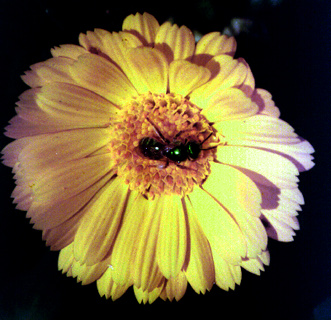
INFORMATION SHEET 21
With the arrival of Africanized honey bees in Arizona, there has been an increased interest in bees, wasps, and other flying creatures. One group of insects that have come to our attention are the so-called solitary bees.
Not all bees live in large family groups like honey bees. In fact of all the bee species, over 90% are solitary bees. Female solitary bees prepare their own nest in the ground, in cracks or crevices in walls, or in wood. They gather nectar and pollen as food for their own offspring, and provide little or no further care after their eggs are laid.
Solitary bees come in many different sizes, colors and shapes. Common solitary bees are mason bees, plasterer bees, digger bees, sweat bees and carpenter bees. They vary in color from basic black to bright metallic green, blue or red. Some solitary bees superficially resemble wasps.
Although most live alone, some solitary bees build nests in groups or "aggregations." Solitary bees may nest close together because the site is particularly choice. Other species regularly nest near bees of the same kind, but each female builds its own nest. In a few species, several female bees use a single entrance hole in the ground, but each female builds her own chamber off a common tunnel.
Have you ever seen the neat circles cut from leaves of roses or bougainvillea? Those are caused by a solitary bee known as the leafcutter bee. The leafcutter bee uses the leaf pieces to line her nest in a hollow twig, or any other opening about the diameter of a pencil. Favorite sites for nesting include tubes of lawn furniture or boring into urethane foam roofing material. Once the female has built her nest, she provisions it with a mixture of pollen and nectar. She lays her egg on the food. The egg hatches into a tiny grub that consumes the food over the period of a week or two, and then pupates. Depending on the time of year and the species of bee, the newly emerged adult bees may fly out of the nest to start new nests, or may stay underground protected in the nest until the following spring.
Carpenter bees are another common example of a solitary bee. The hairy, bluish-black bees you see visiting flowers or hear buzzing by each spring are female carpenter bees. They are over one inch long and about as wide as your thumb. Female carpenter bees are capable of stinging, but are not normally aggressive. They do not sting unless trapped, stepped on or otherwise endangered.
Male carpenter bees are similar in size to females, but are blond or tan-colored. They may act aggressively, but they can't sting (male bees and wasps lack stingers).
Carpenter bees nest in wood, such as dead tree trunks, firewood or exposed wood on structures. They excavate a tunnel about ten inches long within the wood. The female bee then visits local flowers to gather pollen and nectar. The female rolls the pollen into a ball, and pushes it to the back of the tunnel where she lays an egg. She loosely plugs the end with sawdust chips and other materials, forming a chamber roughly one inch long. She then goes to get more pollen and repeats the process until the tunnel is filled with chambers full of growing bees.
Metallic blue or green sweat bees are solitary bees that often nest in aggregations in the soil. It is not known exactly why they do it, but sweat bees are known for their habit of licking sweat from people or animals. They also gather pollen to provide for their offspring. The female bees create chambers within the soil where they lay their eggs on the pollen balls.

Because they don't have a large nest with a lot of offspring to defend, solitary bees tend to be less defensive than bees that live in groups (or "social bees"). Although the females are capable of stinging, they only do so if trapped or otherwise threatened. Unless they are allergic to bee stings, homeowners should not be concerned if they find one or a few solitary bees nesting in their yards.
Usually there is no reason to control solitary bees. They may be considered to be beneficial because they pollinate crops and native plants. Leafcutter bees and alkali bees are encouraged by farmers who grow alfalfa for seed because they pollinate alfalfa better than honey bees. Other solitary bees, such as the shaggy fuzzyfoot, may be active when honey bees are not.